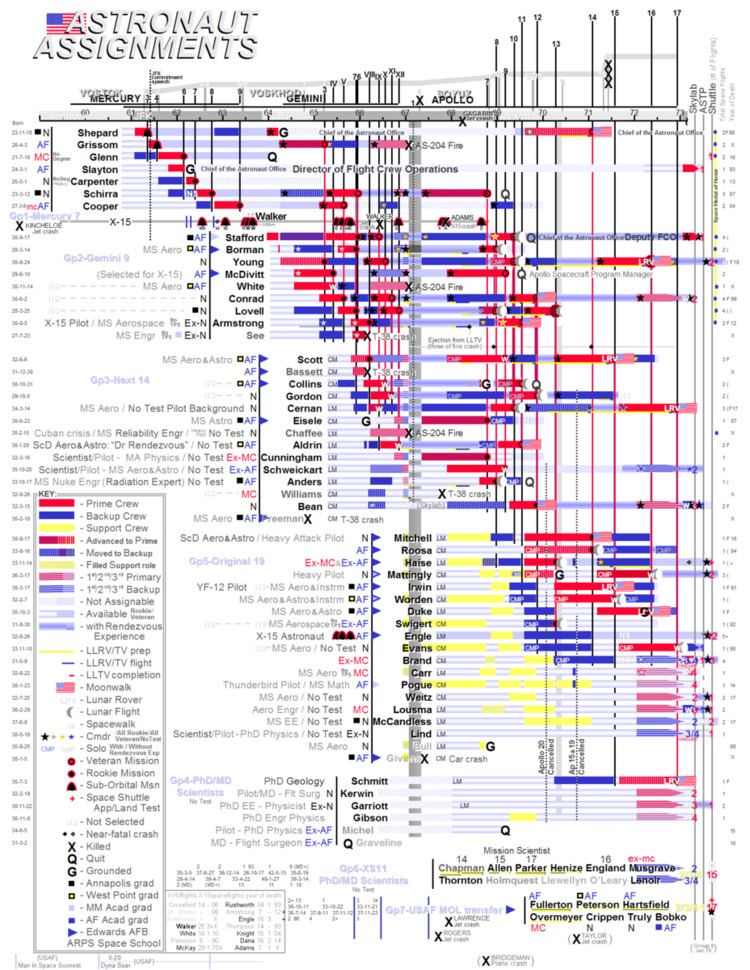NASA's Astronaut Group 5 was selected by NASA in April 1966. Of the six Lunar Module Pilots that walked on the Moon, three came from Group 5. The group as a whole is roughly split between the half who flew to the Moon (nine in all) and the other half who flew Skylab and Shuttle, providing the core of Shuttle Commanders early in that program. This group is also distinctive in being the only time when NASA hired a person into the astronaut corps who had already earned astronaut wings, X-15 pilot Joe Engle. John Young labelled the group the "Original Nineteen" in parody of the original seven Mercury astronauts.
Vance D. Brand (born 1931), U.S. Marine Corps (4 flights)Skylab Rescue — never flownApollo-Soyuz Test Project — July 1975 — Command Module Pilot — First joint U.S./U.S.S.R. missionSTS-5
Columbia — November 1982 — Commander — SBS-C and Anik C-3 satellite deployment missionSTS-41-B
Challenger — February 1984 — Commander — Westar 6 and Palapa B2 satellite deployment mission, first untethered spacewalkSTS-35
Columbia — December 1990 — Commander — ASTRO-1 mission
John S. Bull (1934–2008), U.S. NavyResigned from the astronaut corps after learning that he was suffering from pulmonary disease.
Gerald P. Carr (born 1932), U.S. Marine Corps (1 flight)Skylab 4 — November 1973–February 1974 — Commander — Third crew of the Skylab
space stationCharles M. Duke, Jr (born 1935), U.S. Air Force (1 flight)Apollo 16 — April 1972 — Lunar Module Pilot — Fifth manned lunar landing; tenth person to walk on the moonAlso CAPCOM during landing of
Apollo 11Joe H. Engle (born 1932), U.S. Air Force (2 flights + ALT)ALT
Enterprise — February through October 1977 — CommanderSTS-2
Columbia — November 1981 — Commander — Remote Manipulator System testingSTS-51-I
Discovery — August 1985 — Commander — AUSSAT-I, ASC-I, and Syncom IV-4 satellite deployment; Syncom IV-3 repair missionWas replaced as the Lunar Module Pilot for
Apollo 17 by
geologist Harrison Schmitt after Apollo 18 had been canceled.Engle was the only shuttle pilot who had prior hypersonic flight experience, having earned his astronaut wings flying the
X-15 rocket plane.
Ronald E. Evans, Jr (1933–1990), U.S. Navy (1 flight)Apollo 17 — December 1972 — Command Module Pilot — Last manned lunar landing
Edward G. Givens, Jr (1930–1967), U.S. Air ForceKilled in automobile accident in 1967 while serving on the
Apollo 7 support crew.
Fred W. Haise, Jr (born 1933), U.S. Marine Corps, (1 flight + ALT)Apollo 13 — April 1970 — Lunar Module Pilot — Aborted lunar landing; would have been the sixth person to walk on the moonSlated to land as Commander of Apollo 19ALT
Enterprise — February through October 1977 - CommanderWas to command the original
STS-2 flight to rescue Skylab in 1979.
James B. Irwin (1930–1991), U.S. Air Force (1 flight)Apollo 15 — July 1971 — Lunar Module Pilot — Fourth manned lunar landing; eighth person to walk on the moon
Don L. Lind (born 1930), U.S. Navy (1 flight)Skylab Rescue — never flownSTS-51-B
Challenger — April 1985 — Payload Commander — Spacelab missionHis first and only flown mission in 1985 came 19 years after being selected as an astronaut.
Jack R. Lousma (born 1936), U.S. Marine Corps (2 flights)Skylab 3 — July–September 1973 — Pilot — Second crew of the Skylab space stationSTS-3
Columbia — March 1982 — Commander — Research and development flight
T. Kenneth Mattingly, II (born 1936), U.S. Navy (3 flights)Apollo 16 — April 1972 — Command Module Pilot — Fifth manned lunar landingSTS-4
Columbia — June 1982 — Commander — Final research and development flight, first classified
United States Department of Defense payloadSTS-51-C
Discovery — January 1985 — Commander — First classified
United States Department of Defense mission; deployed USA-8 (Magnum 1)Was the original Command Module Pilot for
Apollo 13, but was grounded due to exposure to
rubella, which he was not immune to.
Bruce McCandless II (born 1937), U.S. Navy (2 flights)STS-41-B Challenger — February 1984 — Mission Specialist — Westar 6 and Palapa B2 satellite deployment mission; McCandless conducted the first untethered EVASTS-31
Discovery — April 1990 — Mission Specialist —
Hubble Space Telescope deployment mission
Edgar D. Mitchell (1930–2016), U.S. Navy (1 flight)Apollo 14 — January 1971 — Lunar Module Pilot — Third manned lunar landing; sixth person to walk on the moon
William R. Pogue (1930–2014), U.S. Air Force (1 flight)Skylab 4 — November 1973–February 1974 — Pilot — Third crew of the Skylab
space stationStuart A. Roosa (1933–1994), U.S. Air Force (1 flight)Apollo 14 — January 1971 — Command Module Pilot — Third manned lunar landing
John L. Swigert, Jr (1931–1982), U.S. Air Force (1 flight)Apollo 13 — April 1970 — Command Module Pilot — Aborted lunar landingIntended as Command Module Pilot on Apollo-Soyuz Test Project but was replaced by Vance Brand because of the
Apollo 15 postage stamp incident
Paul J. Weitz (born 1932), U.S. Navy (2 flights)Skylab 2 — May–June 1973 — Pilot — First crew of the Skylab space stationSTS-6
Challenger — April 1983 — Commander — Maiden flight of
Challenger, TDRS A satellite deployment mission
Alfred M. Worden (born 1932), U.S. Air Force (1 flight)Apollo 15 — July 1971 — Command Module Pilot — Fourth manned lunar landing

